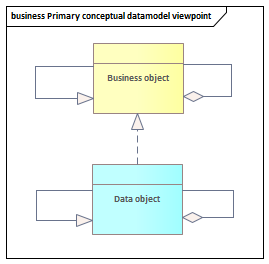
The primary conceptual model consists of two ArchiMate concepts from the passive structure part. Namely data objects and business objects.
Often one of these two entities is used in the models. This depends on the further modeling, finds this place on application level then you can use the data objects, otherwise the business objects
For both entities you can use specialization and aggregation as an association. In addition, a data object realizes a business object. If desired, you can show cardinalities at the associations, but that is not common.
In addition, in a complex model or in many synonyms and homonyms, the modeling of two layers of abstraction can have added value